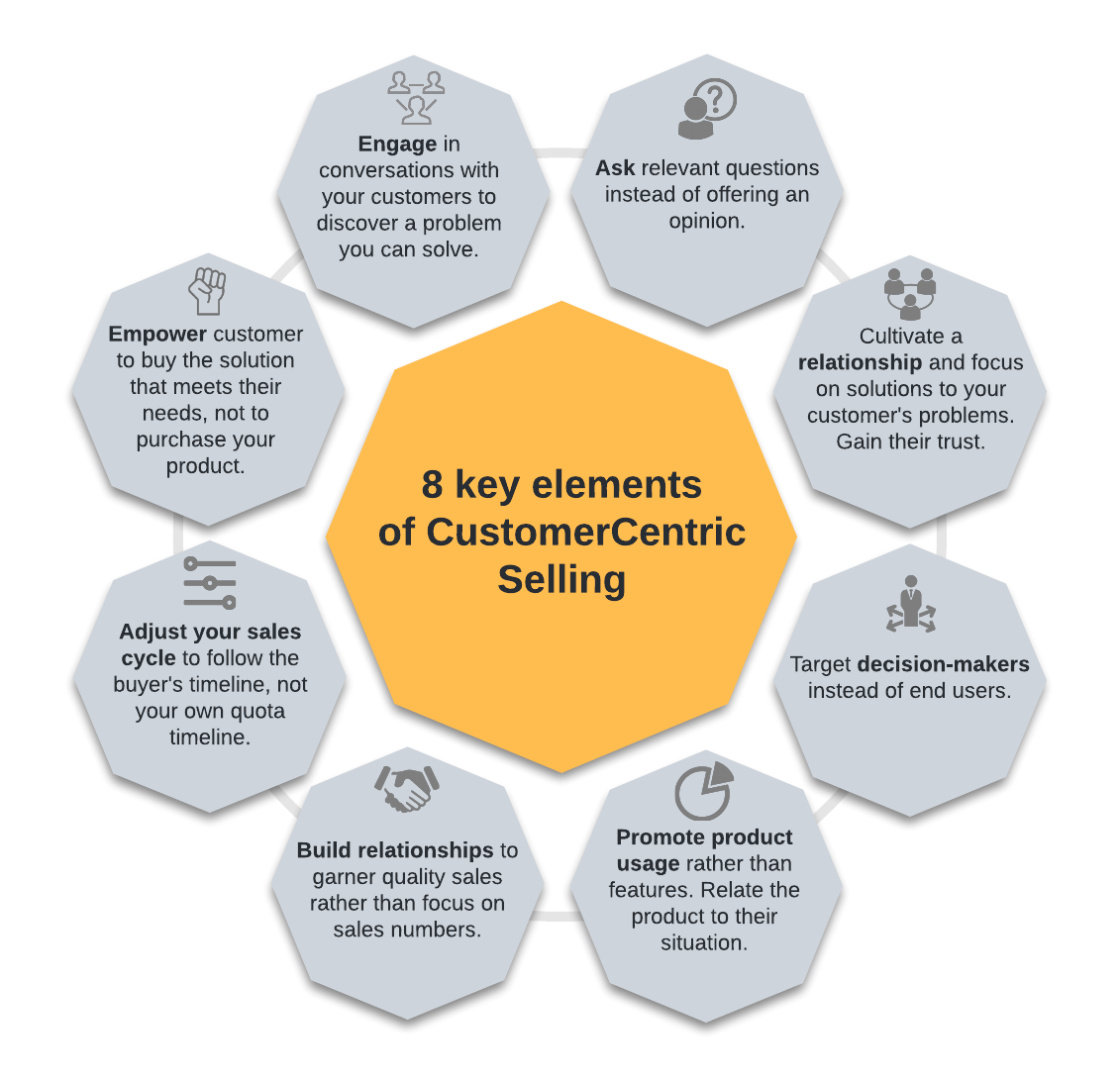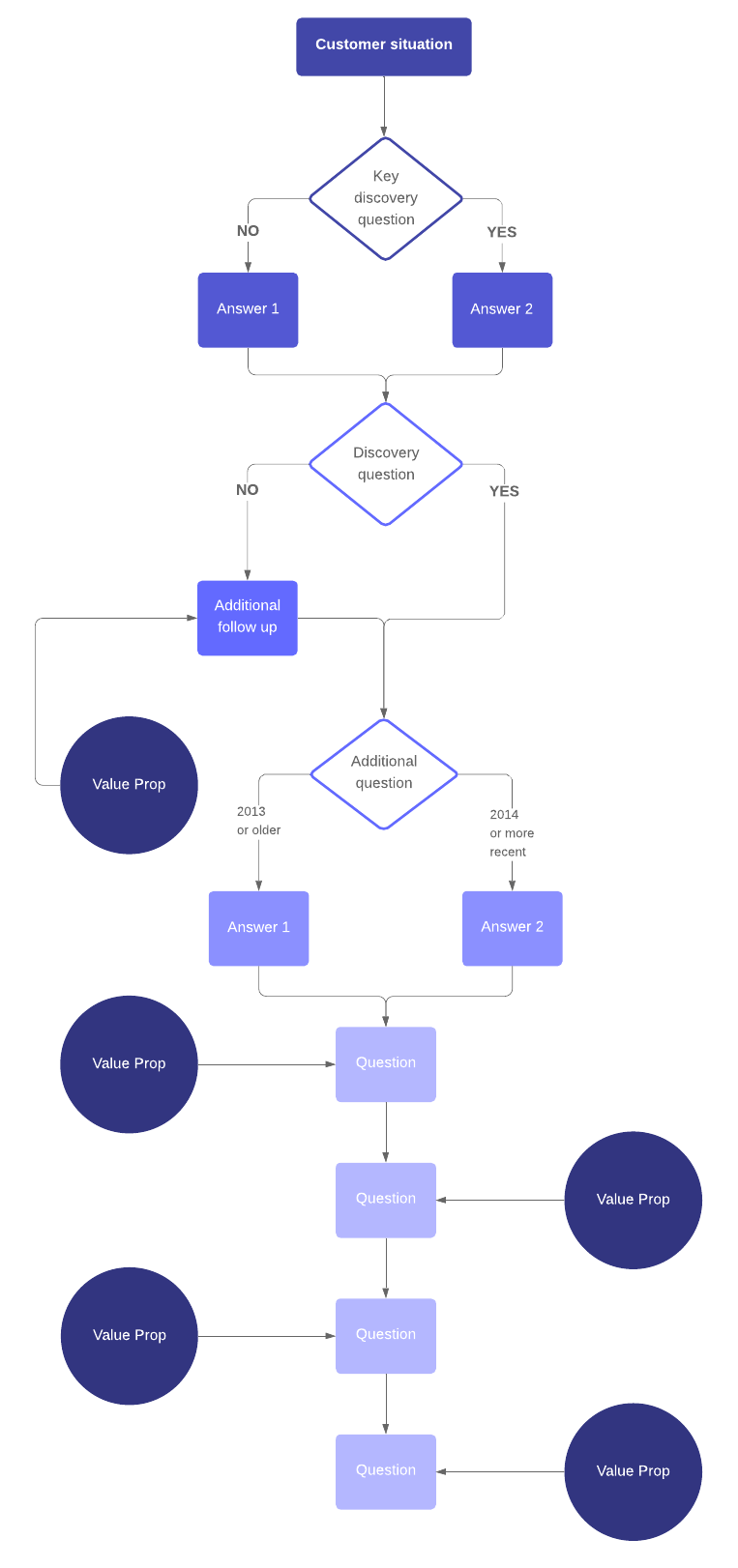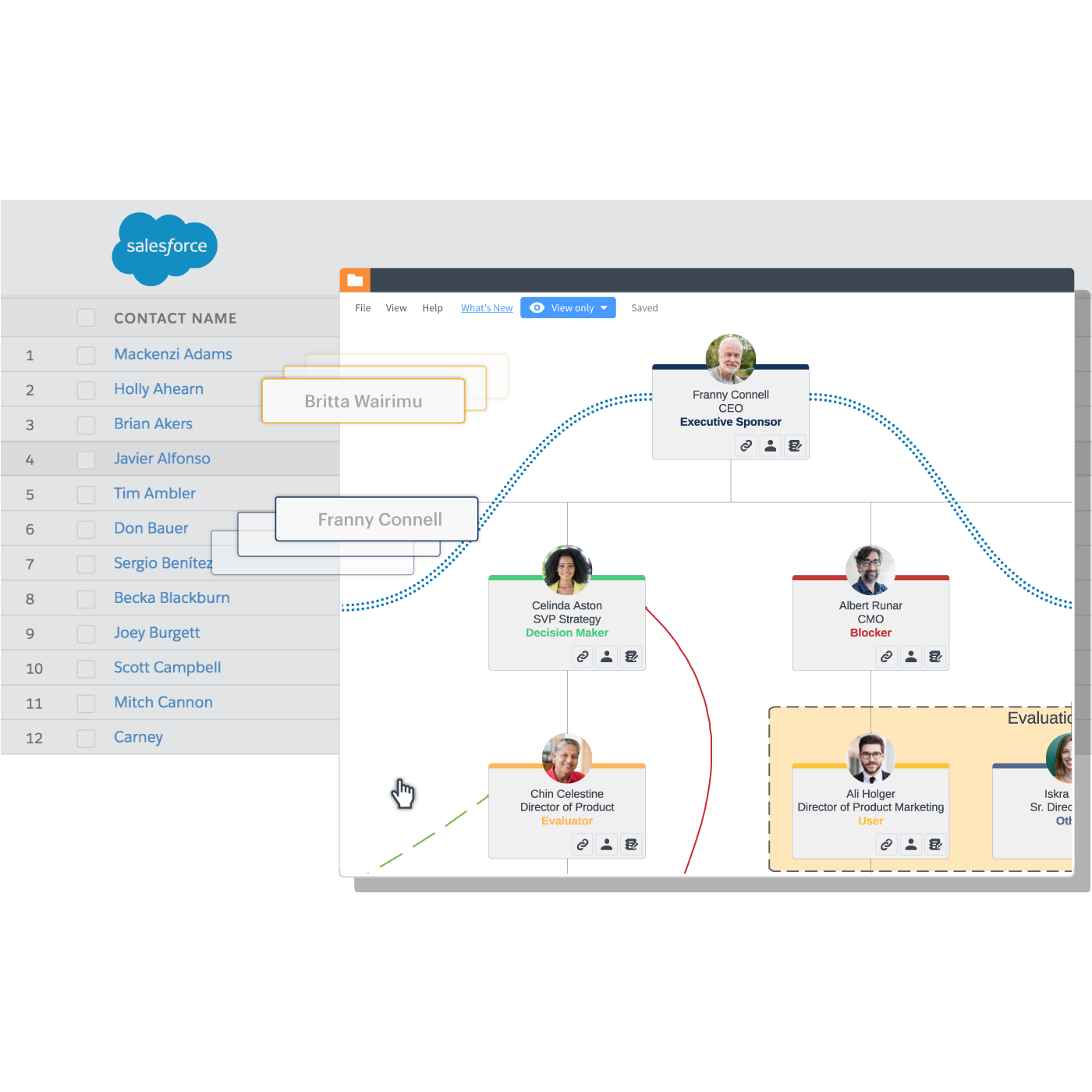
CustomerCentric Selling: Keeping the customer in mind
Lucid Content
Reading time: about 8 min
Topics:
Imagine you’re busy working on a project at home when the doorbell rings. When you answer it, a young person who has ignored your “No Soliciting” sign asks if you would be interested in buying 20 pounds of potatoes for $20.
You can get 20 pounds of potatoes at the grocery store for about $6. Why would you want to buy potatoes for $20? Are they magic potatoes?
The salesperson tells you that the money will be used to help the school’s wrestling team. You don’t have kids who go to that school, you don’t go to wrestling matches, and you don’t need 20 pounds of potatoes. (You may laugh—but this experience is based on a true story.)
What’s in this sales transaction for you?
The point is, your customers do not care why you are selling your product or what you want out of the transaction. A lot of time will be wasted and many opportunities missed if your approach is seller-centric—stressing what you have to sell vs. addressing customer problems that your product can solve.
Instead, try CustomerCentric Selling.
What is CustomerCentric Selling?
In 1997, Steve Jobs had just returned to Apple after being ousted a decade earlier from the company he co-founded. While answering developers’ questions, he said, “One of the things I've always found is that you've got to start with the customer experience and work backwards to the technology. You can't start with the technology and try to figure out where you're going to try to sell it."
Created by sales trainer and best-selling author, Michael Bosworth, CustomerCentric Selling focuses on creating a great customer experience so you stand out from the competition.
It is no longer enough to have the best technology and products. Today’s well-informed buyer has a wealth of information at their fingertips and plenty of choices when they are ready to buy. Cold calls and high-pressure sales presentations no longer work.
According to a Salesforce State of the Connected Customer Report, 80% of customers say that the experience a company provides is as important as its products and services. In addition, 95% say that they are more likely to be loyal to a company that they trust. You can gain that trust by focusing on what you can do for your customers as opposed to what you can sell your customers.

8 key elements of CustomerCentric Selling
Bosworth outlines the following eight aspects of successful CustomerCentric Selling:
- Engage in conversations around situations important to your customer. Remember, you are not making presentations. You are trying to discover a problem you can solve or a need you can fill.
- Instead of offering opinions, ask relevant questions. Offering an opinion when nobody asked for one can be off-putting to some people.
- Cultivate a relationship and focus on solutions to your customer’s problems. Gain customer trust by letting the customer know that you will be with them every step of the way to ensure their success.
- Target decision-makers instead of end-users. A user may want your product, but unless they have the authority to make purchases, you will be wasting time.
- Promote product usage rather than technology and features. Show the customer how the product works in their environment to their benefit.
- Cultivate quality relationships to garner quality sales, rather than focusing on sales numbers. It’s harder to maintain a trusting partnership with customers if you are too busy running around trying to please too many different people.
- Make sure your sales cycle follows the buyer’s timeline. Customers don’t care about your quotas or any bonuses you can get from the sale. If you push too hard and too quickly, you risk losing trust.
- Don’t try to convince customers to purchase your product or service. Instead, empower them to buy the solution that meets their needs.
When employing a customer-centered methodology, each sale needs to realize one of the following three results:
- The customer’s goal is achieved.
- The customer’s problem or key issue is solved.
- The customer’s need is satisfied.
If the sale of your product or service doesn’t achieve any of these three results, you should walk away from the sale. Walking away can ultimately build a good relationship and communicate trust. That same customer will be more willing to engage with you in the future when you do have a product that will fill a need or solve a problem.
How to incorporate CustomerCentric Selling into your sales process
Use the following principles to keep your customer in mind and close more deals.
Understand your customer’s needs
As you do your research and work on development, marketing, sales, and customer support, make everything about the customer.
When meeting with potential customers, use words like “you” and “your” rather than “I” and “we.” Remember, your customers don’t care about your wants or needs—or how well your product is selling in comparison to the competition. Make your conversations about issues important to the customer and ask lots of questions. Work together as partners to identify how you can find solutions.
Treat the conversation like an interview rather than as a sales pitch. Consider diagramming a conversation tree to focus on your customer’s needs (just click the template below to get started!). This tactic will help you tailor your value propositions to their specific situation.

Speak your customer’s language
Do you speak corporate jargon? Chances are that your customers don’t. And they won’t care that your company got all of their ducks in a row, followed best practices, thought outside the box, and took it to the next level to deliver a scalable product at such a terrific price point.
Compare that to this 2001 Apple ad. Apple introduced the first-generation iPod to the world with the simple slogan, “1000 songs in your pocket.” Rather than talking about the player’s 5 GB drive, its weight, battery life, and other technical specifications, Apple gave customers a description they could understand and the iPod changed the music industry.
Align yourself with your customer’s priorities and alleviate fears
Don’t waste time trying to sell customers on products or features that they don’t need. If you spend too much time pushing the customer to buy something they don’t think is needed, you run the risk of losing that customer.
Instead, talk about how your product will solve the customer’s current problems. They don’t need you to bring up solutions to hypothetical problems. By aligning your solutions to problems that the customer is already working on, you have a better chance of building a strong relationship based on trust.
Use current customers to help sell to new customers
Customer success stories can go a long way to helping you sell your products and services to potential customers. Current customers will generally have more credibility with your prospects than even your best and most knowledgeable salespeople. Help your potential customers visualize how current customer success can translate to their own success by using charts, audio, video, websites, and so on.
Adopt a CRM model to increase customer loyalty
A customer relationship management (CRM) model or strategy helps your company be more customer-centric, giving you a better understanding of customer needs and expectations so you can deliver better value.
A CRM model helps you analyze your interactions with customers so you can find ways to optimize your relationships with your best customers. While it is important to get new customers when you can, keeping your existing customers can be cheaper and more profitable in the long run.
Examples of CRM include the IDIC (Identify, Differentiate, Interact, and Customize) model, the QCI (Quality Competitive Index) model, Payne’s Five Forces model, and CRM value chain.
There are many CRM software products that can help you manage all interactions with current and potential customers. These applications let you store important data that will help you maintain strong relationships and increase revenue. Processing and analyzing stored customer information makes it easier for you to identify customer needs, set up meetings, initiate calls, find new sales opportunities, and more.
In addition, CRM software can help you set up rules or triggers that let you know when it is appropriate to contact customers about inventory replacement needs or product updates. This class of software lets you categorize customers by their expectations so you can more easily focus on what they need and when they need it.
Benefits of CustomerCentric Selling for your business
To be successful and survive in business, you must adopt customer-centric strategies.
Customer-centered selling and CRM include the following benefits:
- Placing customers at the center of all your interactions creates strong, flexible, and personalized customer experiences.
- Great customer experiences keep customers coming back to you to solve their business needs.
- Established trust ensures customer loyalty.
- Strong relationships, trust, and customer loyalty lead to increased sales and revenue.
In the long run, centering your efforts on your customers and their sales experience won’t only benefit them. It will benefit you and your business, too.

See how Lucidchart strengthens any sales methodology, creating adherence and uniformity across your org.
Learn moreAbout Lucidchart
Lucidchart, a cloud-based intelligent diagramming application, is a core component of Lucid Software's Visual Collaboration Suite. This intuitive, cloud-based solution empowers teams to collaborate in real-time to build flowcharts, mockups, UML diagrams, customer journey maps, and more. Lucidchart propels teams forward to build the future faster. Lucid is proud to serve top businesses around the world, including customers such as Google, GE, and NBC Universal, and 99% of the Fortune 500. Lucid partners with industry leaders, including Google, Atlassian, and Microsoft. Since its founding, Lucid has received numerous awards for its products, business, and workplace culture. For more information, visit lucidchart.com.
